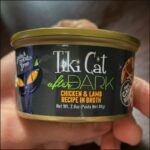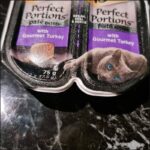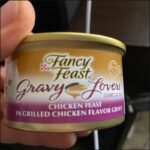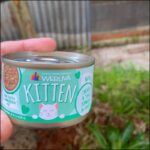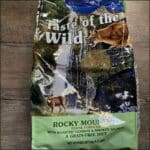Quick answer: Losing weight is about eating fewer calories than burned.
Wet food is four times less calorically dense than dry food, and is portion controlled.
It’s the best option for weight loss.
5 Best Wet Cat Food for Weight Loss
I sorted popular cat foods for calorie content. All are the best rated from my testing.
Tiki Cat After Dark is best.
More below in this guide to the best cat food for weight loss.
I have a background in nutrition and research and test most of the products recommended.
This article isn’t a replacement for medical advice.
See more about us here.
What to Look For in Cat Foods for Weight Loss?
Quick answers:
- Basics of Weight Loss for Cats:
- Aim for a balance of calories in versus calories out.
- Target body condition score of 5 for healthy weight.
- Average cat requires ~300 kcal/day.
- High-risk groups: middle-aged, male, neutered, indoor, free-fed, mixed breed, and those on an all-dry food diet.
- Consequences of Obesity:
- Increased risk of diabetes.
- Decreased mobility and grooming ability.
- Early mortality.
- Buying Tips for Weight Loss Cat Food:
- Ensure AAFCO nutritional adequacy for balanced micronutrients.
- Choose life stage appropriate food: all life stages, growth, maintenance, or supplemental feeding.
- Opt for lower calorie cat food and compare kcal/kg for different types.
- Prefer wet cat food for lower calorie density and portion control.
- Select high protein cat food (at least 40% on dry matter basis) to maintain muscle and metabolic rate.
- Choose low carb options to support weight loss and diabetic health, aiming for fewer than 25% carbs on a dry matter basis.
- Key Considerations:
- Micronutrients are essential for energy, coat, skin, and digestion health.
- Check cat food labels for AAFCO compliance and nutritional adequacy.
- Wet cat food is generally better for weight loss due to lower calorie density and portion control.
- High protein diets are preferred for maintaining muscle mass and metabolic rate.
- Low carb diets are beneficial, especially for overweight cats prone to diabetes.
Long answers:
Weight loss is about calories in vs calories out.
To help your cat lose weight, decrease calories.
Simple?
In theory yes.
The goal is to get your cat to a body condition score of 5. Here’s a body condition score chart to check where they’re at.
The average cat needs ~300 kcal per day to maintain a healthy weight.
Cat’s at most risk of weight gain include:
- Middle aged cats (8-10 years)
- Males
- Neutered cats
- Indoor bound cats
- Free-fed cats
- An ‘all dry cat food’ diet
- Mixed breed cats
More than half of US pets are overweight or obese.
Addressing your cats weight is important to prevent the following:
- Increased risk of feline diabetes
- Decreased mobility and inability to groom
- Early mortality
Here’s our buying tips:
AAFCO Nutrition Guidelines
Decreasing calories helps cats lose weight, but they still need enough micronutrients.
These help keep your cats energy levels, coat, skin and digestion in top shape.
Micronutrients include vitamins and minerals. There are 25 micronutrients needed for health.
A deficiency of micronutrients leads to disease and poor health.
How do you know if your cat food has enough of these nutrients?
Check the label.
The Association of American Feed Control Officials (AAFCO) defines how many micronutrients cats need for good health.
The label shows if the cat food meets these nutrient guidelines.
Look for the following statement:
[insert food] is formulated to meet the nutritional levels established by the AAFCO Cat Food Nutrient Profile for [insert lifestage]:
Cat food is either suited to sole feeding and supplemental feeding.
Supplemental cat foods do not contain all the nutrients your cat needs. These are only good for occasional feeding.
Sole feeding cat foods are a complete meal that you can feed your cat exclusively.
However, you also want to make sure the cat food is life stage appropriate. Cats need more or less nutrients at different stages of life.
Here are the following categories of cat food:
- All life stages: Sole feeding option for all life stages
- Growth: Sole feeding option for kittens and lactating cats
- Maintenance: Sole feeding option for adults (1-7 years)
- Supplemental feeding: Only for treats or toppers. Not a complete meal.
As an example, if you have a three year old cat, you can go with maintenance cat food.
For a kitten aged eight months, you’d want to use cat food for growth or all life stages.
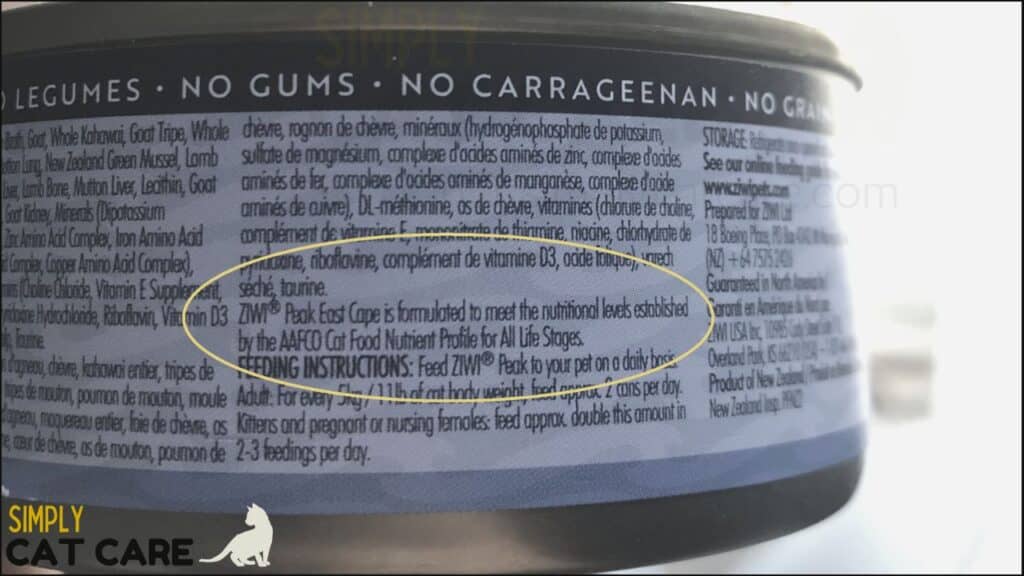
Choose Lower Calorie Cat Food
If you’re trying to reduce the calories in your cat’s diet for weight loss, choose lower calorie food.
Logical right?
To find out the calorie content, check the side or back of the cat food label.
It will come in either serving size (either per cup or per tin for dry and wet foods respectively) and/or kcal/kg basis.
The best way to compare different cat foods is by looking at the kcal/kg. This way you can compare dry, wet, pouched and canned foods easily.
Lower calories = better for weight loss.
Wet Cat Food is Best
Using the calorie comparison, it’s easy to see that wet cat food is your best option for weight loss.
Wet cat food has four times less calories per weight.
This is one of the reasons for high rates of obesity in cats only fed dry cat food, especially when free fed.
Free-feeding is unique to dry cat food and a key reason for weight gain.
The combination of being able to freely pour dry cat food at will and the huge calorie density are what make dry cat food less optimal for weight loss.
Wet cat food with its portion control design and lower calorie content is much more appropriate.
Choose High Protein Cat Food
Choosing any old low calorie cat food won’t do.
You’ll want to make sure you’re choosing high protein options.
Why?
A high protein diet helps maintain muscle and keep the metabolic rate high.
High protein diets also decrease insulin requirements in diabetic cats. Overweight cats have a higher risk of diabetes.
Cats also prefer a high protein diet. A low protein diet can result in food rejection in fussy eaters.
I suggest aiming for at least 40% protein on a dry matter basis.
This covers the needs of cats of all life stages and provides extra for fussy cats.
Use an online calculator.
Use the guaranteed analysis on the back of the label and pop that into the calculator.
Choose Low Carb Cat Food
Why would a low carb diet be helpful for weight loss?
When lowering calories, you have to cut calories from either or all macronutrients:
- Protein
- Fat
- Carbohydrate
Both fat and carbohydrate provide energy (calories) in the diet. Fat is more calorically dense than carbohydrates (9kcal/g compared to 4kcal/g).
So why not cut out the fat instead?
When given a choice, cats prefer a moderate-fat diet (25%) over a low-fat diet (10% energy). Animal fats like tallow are the tastiest fat sources for cats.
Interestingly, there’s some evidence (from the late 1990’s) that economy dry food is associated with leanness in cats. Budget dry food is usually higher in carbs (not always).
Why would high carb diets help?
Cat’s can reject high carb foods due to the ‘carbohydrate ceiling’ effect. This might protect a cats body, which is sensitive to high carb intakes.
The problem is this creates shortfalls of protein, a nutrient critical to a cats health.
So it’s an interesting idea in theory, but in practice maybe not ideal.
A low carb diet also improves the health of diabetic cats. Since many overweight cats have or may get diabetes, it’s a good idea to keep carbs low.
Keep in mind that cats have no dietary requirement for carbohydrates, so there’s no issue with it being removed.
Some sources have suggested high carb diets are superior for weight loss and recommend dry cat food with four times more caloric density.
Does that make sense?
No.
Experts suggest aiming for fewer than 25% carbs dry matter, or even less in diabetic cats (15%). Fortunately, most wet cat food is low carb anyway so it’s not hard to meet this.
FAQ
Quick answers:
- Best Cat Food for Weight Los?
- Wet cat food is best.
- Wet food is less calorie dense compared to dry cat food.
- Canned cat food is linked to a lower risk of obesity.
- Human-grade raw diets are protective but controversial.
- How Can Overweight Cats Lose Weight?
- Focus on reducing calorie intake and increasing calorie expenditure.
- Offer lower calorie cat food.
- Consider factors that complicate weight loss: neutering, age, lack of exercise, calorically dense diets, and free feeding.
- Neutering and Weight Loss?
- Neutering lowers metabolism and increases food intake; manage with lower calorie food.
- Environmental Enrichment for Weight Loss?
- Use cat trees, perches, scratching boards, and toys to increase activity.
- Wet Food for Weight Loss?
- Recommended due to lower calorie density and portion control.
- Indoor Cats and Weight Loss?
- Monitor calorie intake closely due to reduced exercise opportunities.
- Use online calculators to determine feeding amounts.
- Dry vs Wet Food for Overweight Cats?
- Wet food is recommended for better calorie control.
- Avoid free-feeding dry food to prevent overeating.
- Identifying Overweight Cats?
- Use a body and muscle condition chart.
- Signs include inability to feel ribs, bloating, and fat accumulation.
- Age-Related Weight Gain?
- Middle-aged cats are at higher risk due to lower metabolic rates.
- Feeding Overweight Cats?
- Use online calculators and the Cat Plus Person (CPP) method for precise feeding amounts.
- Best Low Fat Wet Cat Food?
- Tiki Cat After Dark, with low fat and high protein content, is recommended for overweight cats.
Longer answers:
Conclusion
To lose weight, give cats a low calorie diet.
A high protein wet cat food is the best choice for weight loss.
Weigh your cat and use a calculator. Portion the right amount by checking the label of cat food.
Add toys and other items for play. This helps your cat burn more calories.
>> Top recommendation for weight control: Tiki Cat After Dark
Related:
Resources:

